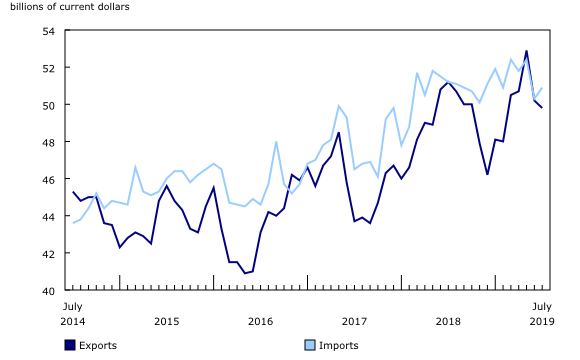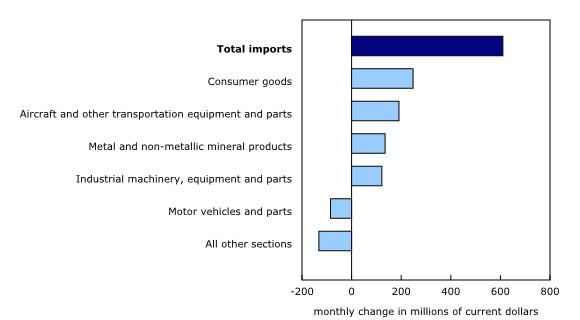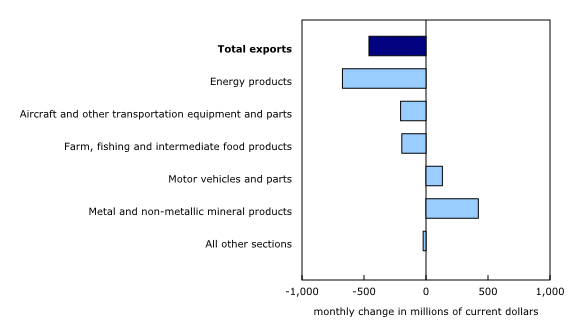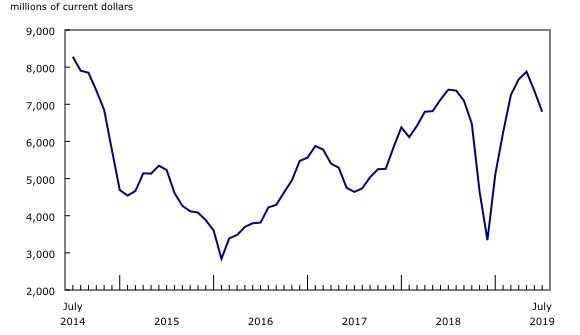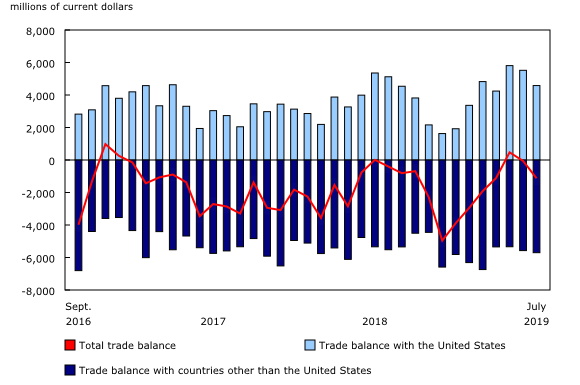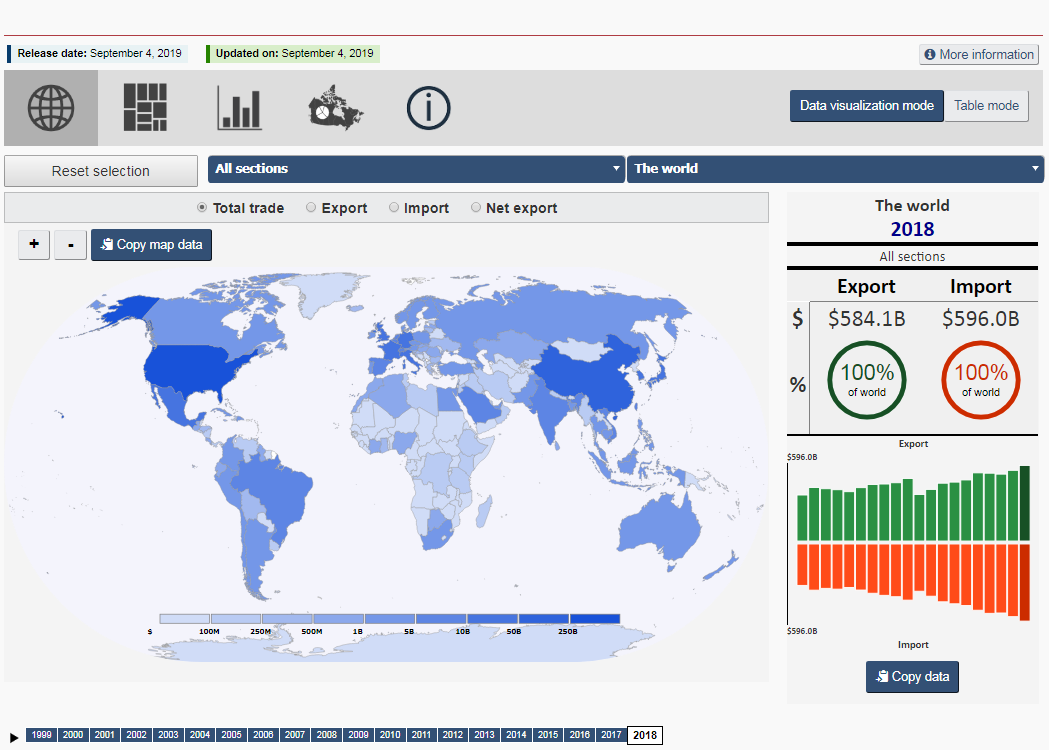Canadian international merchandise trade, July 2019
Archived Content
Information identified as archived is provided for reference, research or recordkeeping purposes. It is not subject to the Government of Canada Web Standards and has not been altered or updated since it was archived. Please "contact us" to request a format other than those available.
Released: 2019-09-04
After a strong decline in imports and exports in June, imports rose 1.2% in July, while exports fell 0.9%. As a result, Canada's merchandise trade balance with the world went from an essentially balanced position in June (slight deficit of $55 million) to a $1.1 billion deficit in July.
The slight trade deficit in June, which was originally reported as a $136 million surplus, remains within the typical margins for revisions to the trade balance in subsequent months.
Imports increase in July after a sharp decline in June
Following a 4.0% decrease in June, total imports rose 1.2% to $50.9 billion in July, with gains in 6 of 11 product sections. In real (or volume) terms, imports were up 2.3%.
Imports of consumer goods (+2.4%) contributed the most to the increase, driven by higher imports of pharmaceutical products (+19.7%), which hit a record high in July, mainly as a result of gains in imports from Switzerland and Germany.
Imports of aircraft and other transportation equipment and parts (+10.2%) also contributed to the increase in July. Higher imports of locomotive cars used to transport crude oil, and parts for armoured vehicles were behind the growth.
Following a 13.6% drop in June, imports of metal ores and non-metallic minerals were up 12.6% in July, largely on the strength of other metal ores and concentrates. Higher imports of bauxite and aluminum oxide—used in aluminum production—contributed the most to the gain in July, as activities at certain aluminum smelters resumed. Gold imports also rose, driven mainly by increased shipments from Japan and Peru.
Energy product prices behind decrease in exports
After a strong decrease of 5.0% in June, total exports fell again in July, down 0.9% to $49.8 billion. Despite this decline, 6 of 11 product sections recorded increases, and non-energy exports rose 0.5%. In real (or volume) terms, exports edged down 0.1%.
Following a 6.7% decline in June, energy product exports fell by 6.7% again in July, as a result of lower crude oil exports (-7.7%). As was the case in June, crude oil export prices (-7.4%) were behind the decrease in July. Crude oil export volumes, which peaked in June, remained at a high level in July, edging down 0.3%.
Exports of farm, fishing and intermediate food products were down 5.4% in July, mainly as a result of lower wheat exports (-20.9%). Despite the decrease in July, wheat exports for this crop year (August 2018 to July 2019) were 11.2% higher compared with the previous crop year.
These declines were partially offset by an 8.5% increase in exports of metal and non-metallic mineral products in July. Gold exports contributed the most to the gain, on higher exports of refined gold to the United States and transfers of gold within the banking sector. Exports of unwrought aluminum (+18.2%) were also up in July, following a 36.4% increase in June, the first full month after the removal of US tariffs on Canadian aluminum.
Trade surplus with the United States narrows
Exports to the United States fell 1.1% in July, while imports from this country were up 1.6%. Following a strong surplus in May and June, Canada's trade surplus with the United States narrowed to $4.6 billion in July.
When the average exchange rates of June and July are compared, the Canadian dollar gained 1.0 US cent relative to the American dollar. This was the second consecutive monthly increase of 1.0 cent.
Imports from countries other than the United States rose 0.5% to $18.4 billion. Higher imports from Switzerland (pharmaceutical products) and Belgium (parts for armoured vehicles and pharmaceutical products) were partially offset by lower imports from China (various products) and the United Kingdom (aircraft parts).
Exports to countries other than the United States edged down 0.3% to $12.7 billion. Lower exports to China (metal ores and pork) were partially offset by higher exports to Hong Kong (gold). As a result, Canada's trade deficit with countries other than the United States widened from $5.6 billion in June to $5.7 billion in July.
Revisions to June exports and imports
Revisions reflect initial estimates being updated with or replaced by administrative and survey data as they become available, as well as amendments made for late documentation of high-value transactions. Exports in June, originally reported as $50.3 billion in the previous release, were revised to $50.2 billion. Imports in June, originally reported as $50.2 billion in the previous release, were revised to $50.3 billion in the current month's release.
The International Trade Explorer goes online
Today, Statistics Canada is releasing a set of user-friendly tools that will help Canadians learn more about the country's trade activities, and how these have evolved over time. Leveraging the analytical richness of customs data, the "International Trade Explorer" offers four different visualization tools: an interactive world map, a tree map, a stacked bar chart and a visualization tool for trade by province.
Data and infographics on free trade agreements
In addition, today Statistics Canada is publishing a new table featuring monthly customs data on Canadian international merchandise trade with member countries of free trade agreements. Table 12-10-0140-01 includes data for member countries of agreements in force in Canada, as well as data for countries with which free trade discussions have begun.
An infographic, "A look at free trade in Canada," on free trade agreements in force in Canada has also been published today.
Note to readers
Merchandise trade is one component of Canada's international balance of payments (BOP), which also includes trade in services, investment income, current transfers, and capital and financial flows.
International trade data by commodity are available on both a BOP and a customs basis. International trade data by country are available on a customs basis for all countries and on a BOP basis for Canada's 27 principal trading partners (PTPs). The list of PTPs is based on their annual share of total merchandise trade—imports and exports—with Canada in 2012. BOP data are derived from customs data by making adjustments for factors such as valuation, coverage, timing and residency. These adjustments are made to conform to the concepts and definitions of the Canadian System of National Accounts.
For a conceptual analysis of BOP versus customs-based data, see "Balance of Payments trade in goods at Statistics Canada: Expanding geographic detail to 27 principal trading partners."
For more information on these and other macroeconomic concepts, see the Methodological Guide: Canadian System of Macroeconomic Accounts (13-607-X) and the User Guide: Canadian System of Macroeconomic Accounts (13-606-G).
Data in this release are on a BOP basis and are seasonally adjusted. Unless otherwise stated, values are expressed in nominal terms, or current dollars. References to prices are based on aggregate Paasche (current-weighted) price indexes (2012=100). Volumes, or constant dollars, are calculated using the Laspeyres formula (2012=100).
For information on seasonal adjustment, see "Seasonally adjusted data – Frequently asked questions."
Revisions
In general, merchandise trade data are revised on an ongoing basis for each month of the current year. Current-year revisions are reflected in both the customs and BOP-based data.
The previous year's customs-based data are revised with the release of the January and February reference months, and then on a quarterly basis. The previous two years of customs-based data are revised annually and revisions are released in February with the December reference month.
The previous year's BOP-based data are revised with the release of the January, February, March and April reference months. To remain consistent with the Canadian System of Macroeconomic Accounts, revisions to BOP-based data for previous years are released annually in December with the October reference month.
Factors influencing revisions include the late receipt of import and export documentation, incorrect information on customs forms, replacement of estimates produced for the energy section with actual figures, changes in classification of merchandise based on more current information, and changes to seasonal adjustment factors.
For information on data revisions for crude oil and natural gas, see "Revisions to trade data for crude oil and natural gas."
Revised data are available in the appropriate tables.
Real-time data table
Real-time table 12-10-0120-01 will be updated on September 16.
Next release
Data on Canadian international merchandise trade for August will be released on October 4.
Products
The product "International Trade Explorer" (71-607-X) is now available on line. This product provides a new way of looking at Canada's trade relations. Leveraging the analytical richness of customs data, this product offers four different visualization tools: an interactive world map, a tree map, a stacked bar chart and a visualization tool for trade by province.
Customs-based data are now available in the Canadian International Merchandise Trade Database (65F0013X).
The updated Canada and the World Statistics Hub (13-609-X) is now available online. This product illustrates the nature and extent of Canada's economic and financial relationship with the world using interactive graphs and tables. This product provides easy access to information on trade, investment, employment and travel between Canada and a number of countries, including the United States, the United Kingdom, Mexico, China, Japan, Belgium, Italy, the Netherlands, Spain and many others.
Contact information
For more information, contact us (toll-free 1-800-263-1136; 514-283-8300; STATCAN.infostats-infostats.STATCAN@canada.ca).
To enquire about the concepts, methods or data quality of this release, contact Benoît Carrière (613-415-5305; benoit.carriere@canada.ca), International Accounts and Trade Division.
- Date modified:




